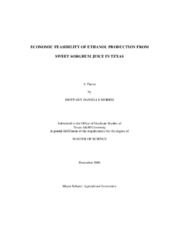| dc.description.abstract | Environmental and political concerns centered on energy use from gasoline have
led to a great deal of research on ethanol production. The goal of this thesis is to
determine if it is profitable to produce ethanol in Texas using sweet sorghum juice.
Four different areas, Moore, Hill, Willacy, and Wharton Counties, using two
feedstock alternatives, sweet sorghum only and sweet sorghum and corn, will be
analyzed using Monte Carlo simulation to determine the probability of economic
success. Economic returns to the farmers in the form of a contract price for the average
sweet sorghum yield per acre in each study area and to the ethanol plant buying sweet
sorghum at the contract price will be simulated and ranked.
The calculated sweet sorghum contract prices offered to farmers are $9.94,
$11.44, $29.98, and $36.21 per ton in Wharton, Willacy, Moore, and Hill Counties,
respectively. The contract prices are equal to the next most profitable crop returns or ten
percent more than the total cost to produce sweet sorghum in the study area. The wide variation in the price is due to competing crop returns and the sweet sorghum growing
season.
Ethanol production using sweet sorghum and corn is the most profitable
alternative analyzed for an ethanol plant. A Moore County ethanol plant has the highest
average net present value of $492.39 million and is most preferred overall when using
sweet sorghum and corn to produce ethanol. Sweet sorghum ethanol production is most
profitable in Willacy County but is not economically successful with an average net
present value of $-11.06 million. Ethanol production in Hill County is least preferred
with an average net present value of $-712.00 and $48.40 million when using sweet
sorghum only and sweet sorghum and corn, respectively.
Producing unsubsidized ethanol from sweet sorghum juice alone is not profitable
in Texas. Sweet sorghum ethanol supplemented by grain is more economical but would
not be as profitable as producing ethanol from only grain in the Texas Panhandle.
Farmers profit on average from contract prices for sweet sorghum when prices cover
total production costs for the crop. | en |


